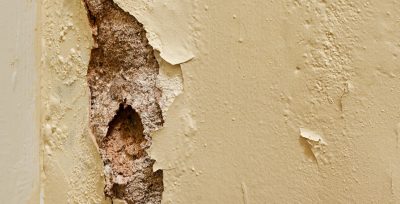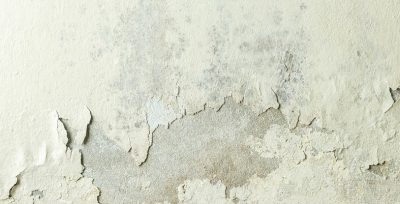Rising damp moves in a stealthy manner and is sometimes hard to pinpoint or identify. If rising damp is not heeded, the structural damage over time can be colossal and remedial measures will be more expensive. It’s imperative to recognize the symptoms of rising damp and tackle them immediately.
What is Rising Damp?
Rising damp in buildings is generally an offshoot of groundwater and accompanying salts diffusing into and up the walls and entering into bricks. The porous nature of bricks and mortar encourages the capillary action that causes water to rise up. In addition, the timber in the skirting and floorboards may also be affected.
Remember that rising dampness always moves upwards while penetrating damp moves in a horizontal fashion, across walls and ceilings.
Signs of rising damp
You don’t need to be an expert or have professional equipment to identify rising damp– a look at the walls and a touch is all that is needed. Rising damp, which can occur on the exterior and interior walls, is more often a result of broken roof tiles, leaking pipes or ground moisture that tends to rise vertically upwards. Internal and external walls may become patchy and tide lines that rise up the walls may appear.
Often it’s hard to tell whether the dampness is caused by rising damp, penetrating damp or surface condensation. Here’s what to look out for.
Rising and Penetrating Damp Prevention and Treatment Services in London
- 01Rising & Penetrating DampRead more
- 02What Is Penetrating DampRead more
- 03What is Rising DampRead more
- 04Causes of Rising DampRead more
- 05Causes Of Penetrating DampRead more
- 06Symptoms of Rising dampRead more
- 07Symptoms of Penetrating DampRead more
- 08Rising Damp vs Penetrating DampRead more
- 09Stop Penetrating DampRead more
- 10Stop Rising DampRead more
- 11What is a Damp Proof CourseRead more
Typical signs that can identify rising damp include:
Tide marks and damp staining
Rising damp tends to leave tide marks on the walls that generally appear a little above the skirting board (1-1.5 meters). Groundwater contains salts and when the water evaporates, the salts are deposited on the walls causing tide marks. Accumulation of salts can damage masonry and the plaster. Sometimes, brownish or yellowish colourations appear and these should be taken seriously.
Peeling wallpaper
Peeling wallpaper is an ominous sign. The paper warps and curves up and in extreme cases of rising damp peels away from the wall. Also, watch out for flaky or damaged paint.
Salts within the plaster
White fluffy deposits on the plaster indicate the presence of rising dampness. More often than not, when the water evaporates, the sulphates in the salts cause white, blistering patches to be left behind.
Black Mould
Black mould is a sure sign that dampness is afoot in that particular area. The fact is reinforced if there is no evidence of black mould elsewhere in the property.
Signs of damp in a house
Dampness anywhere in the house is a sign that unwanted moisture has made its way in and is affecting the floors, walls or ceilings. So, it’s important to know what signs to watch out for. Dampness on the first floor or above is usually an offshoot of condensation or other damp issues. So, it’s important to identify the nature of dampness. Some of the common signs of rising damp inside a house include-
- Damp patches that start at floor level and move vertically upwards (not horizontally)
- Heavy condensation on windows
- Rotting timber, damp skirting boards, wet and lifting floor tiles, carpet or vinyl
- Warping wallpaper, peeling paint, blisters and white fluffy material on walls due to the crystallisation of salts
- Brown or yellow tide marks or discoloured patches on walls, fragmenting plaster
- A damp and musty smell
- The appearance of mould or mildew on walls, floors or ceilings
- Cold walls, floors or ceilings
- A musty, damp smell is a sure give-away
Rising damp is serious and any delay in tackling it can be costly. If there appears to be an issue, get professional help as soon as possible.
Identifying rising damp – misdiagnosis
Mere telltale signs of tide marks do not indicate a rising dampness problem. There could be other reasons. It’s important to rule out other possibilities before treatment. Consider the following-
- Is the plumbing at fault
- Can leaking or faulty guttering be the culprit? Do the gutters have vegetation growing out of them
- Was damp-proofing done over the last 20 years
- Are there cracks in the brickwork or stonework
- Is there damp-staining on the walls adjacent to water pipes
- Can defective pointing be the cause of your damp issue
How to identify signs of rising damp with an Electrical Moisture Meter?
An electrical moisture meter helps to establish a ‘moisture profile’ and identify the reasons for the dampness.
How to check for damp?
Early indications of dampness are a damp and musty smell. Check for rising damp by running over the affected area with your hands. A temperature difference, the presence of plaster salts or white deposits, crunching sounds when the hand is moved across the wallpaper are clear indicators that a rising damp issue has surfaced. Damp patches and lifting floor or tiles are reinforcers.
However, there is nothing equal to having professional advice from an expert. Surveyors can check for dampness (inside and outside), identify the nature of dampness and suggest treatments to solve the issue.
How to fix damp?
Dampness is worrisome to home-owners. We conduct professional and specialist surveys to identify damp issues and offer effective damp proofing treatment, regardless of the cause. Our surveyors are bound by the ‘Code of Practice’ in accordance with the Property Care Association Rules.
Certificated Surveyors in Remedial Treatment (CSRT) assess the condition and suggest modes of treatment. Reports with quotations are given to home-owners for due consideration.
FAQs
Can rising damp cause structural damage?
How do you get rid of the rising damp smell?


